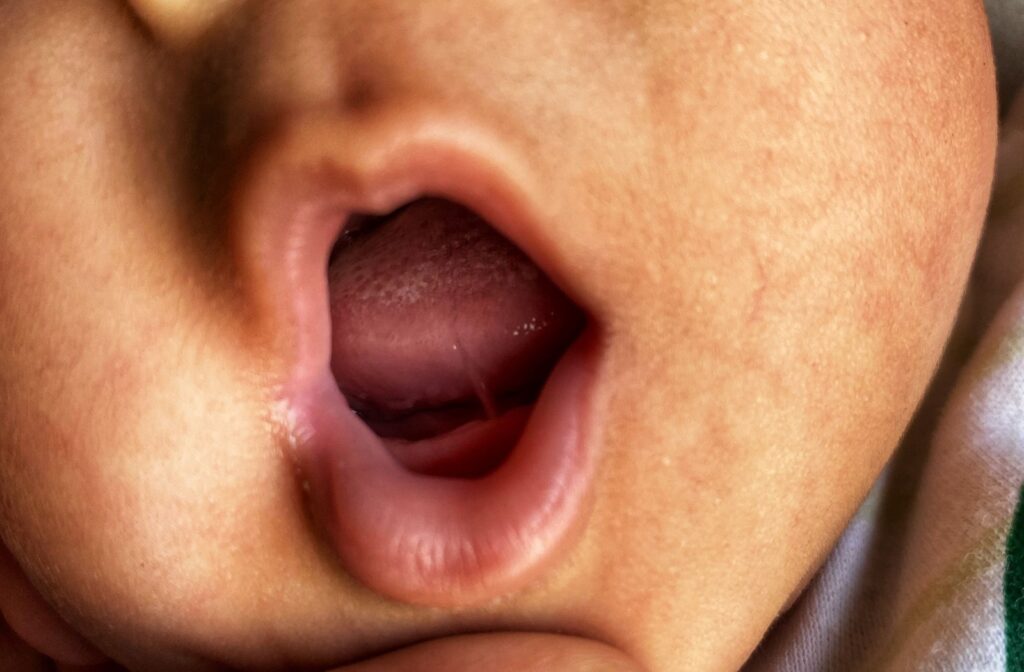You might not think much about how your tongue moves, but even a small restriction can make a big difference in daily life. Tongue ties in newborns can affect everything from feeding in infancy to speech and oral function later in life.
Although tongue ties can be treated at any age, early intervention often leads to more seamless and effective outcomes. A dental office that offers tongue tie evaluations can assess whether treatment is necessary at any age.
If you’re concerned about your child’s tongue tie or experiencing limitations yourself, booking an assessment with a dentist can provide clarity on the best approach.
What Is a Tongue Tie?
A tongue tie, or ankyloglossia, is a condition where the thin band of tissue (the frenulum) connecting the tongue to the bottom of the mouth is too tight or too short, restricting tongue movement. While it may sound like a minor inconvenience, it can cause significant challenges in daily life, especially for infants and children.
What Is a Frenectomy?
A frenectomy is a simple surgical procedure used to treat tongue tie. It involves cutting or modifying the frenulum to free up tongue movement. This procedure is typically quick, minimally invasive, and can significantly improve feeding, speech, and overall quality of life, especially in young children.
How Tongue Ties Affect Infants, Children, & Adults
Infants
For newborns, a tongue tie can make breastfeeding difficult. Babies may struggle to latch properly, leading to discomfort for the mother and insufficient milk intake for the baby. This can result in poor weight gain and increased fussiness.
Children
If untreated, tongue ties in children can impact speech development, making it difficult to form certain sounds properly. They may also experience challenges with eating, such as difficulty swallowing or chewing.
Adults
While less common, some adults with untreated tongue ties may notice speech impediments, challenges with oral hygiene, or discomfort when managing certain foods.
Signs That a Tongue Tie May Need Treatment
How can you tell if a tongue tie requires intervention? Look for these signs at different life stages:
- Infants: Difficulty latching during breastfeeding, extended feeding times, irritability during feeding, or low weight gain.
- Children: Delayed speech development, difficulty pronouncing certain sounds, or trouble eating.
- Adults: Speech difficulties, restricted tongue movement, or ongoing oral health challenges like gum issues or discomfort while eating.
If you’re unsure, a specialist can perform a quick oral assessment to determine whether a tongue tie is the cause of your concerns.
When Is the Best Age to Treat a Tongue Tie?
While tongue ties can be treated at any age, addressing them earlier often results in smoother outcomes. For maximum benefit, treatment is generally recommended during infancy or early childhood, as this is when the tongue plays a significant role in feeding and speech development.

Treating Tongue Ties in Infants: Pros & Cons
Pros of Infant Treatment
- Improved Feeding: Many parents notice immediate benefits after a frenectomy, such as better latching during breastfeeding.
- Reduced Maternal Discomfort: Treating the tongue tie can alleviate pain for breastfeeding mothers, like cracked or sore nipples.
- Early Prevention: Correcting a tongue tie early can avoid future complications with speech and eating.
Cons of Infant Treatment
- Healing Process: Although most infants heal quickly, the recovery involves post-procedure care like gentle stretching exercises to ensure proper healing.
- Timing and Adjustment: Parents may need to make adjustments to their feeding routine following the procedure.
Can Tongue Ties Be Corrected Later in Childhood?
Yes! Many children undergo a frenectomy after infancy. Older children may have already developed some compensatory behaviours, such as adapting their speech or eating habits, and treatment can help eliminate these issues. However, speech therapy may still be needed post-procedure to help children adjust to their new tongue mobility.
Is It Ever Too Late to Fix a Tongue Tie?
It’s never too late! Adults can benefit from tongue tie treatment, especially if the condition is creating ongoing issues. Many adults see improvement in speech clarity, comfort during meals, and even relief from jaw or oral discomfort after treatment.
When to See a Specialist for Tongue Tie Treatment
If you or your child are experiencing any of the symptoms mentioned earlier, consider seeing a specialist. A simple oral assessment can provide clarity on whether a tongue tie is the underlying issue and if treatment is recommended.
Infant Frenectomies at Hometown Dental
At Hometown Dental, our team takes a patient-centred approach to care, specializing in minimally invasive tongue tie treatments. Using advanced laser technology, we ensure that the process is quick, gentle, and effective.
Start the Journey to Better Speech & Feeding
Addressing a tongue tie can improve quality of life in ways you may not have thought possible. Whether it’s helping a baby latch better, giving a child enhanced speech confidence, or making meals more enjoyable for an adult, the benefits are worth exploring.
If you’ve noticed any of the signs listed in this blog, it’s time to take the next step. Contact Hometown Dental to book an appointment, and see how we can help you or your loved one thrive.





